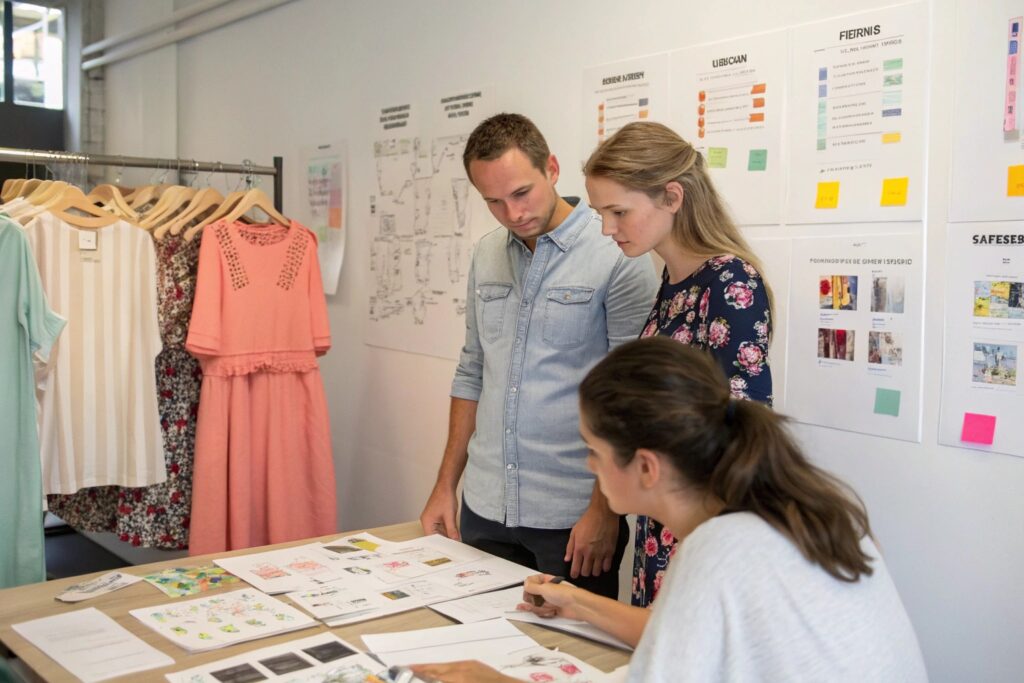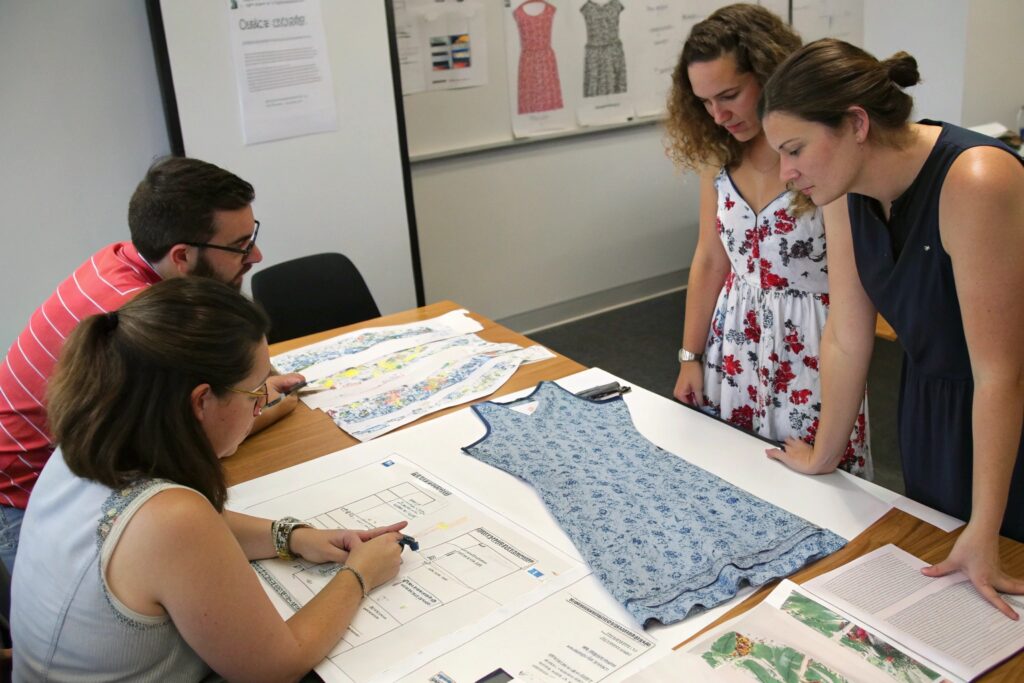Capsule collections promise agility—but if your batch size is off, even the smartest capsule can backfire.
Batch size affects everything from production speed to price to flexibility. Choosing the right one is key to capsule success in kidswear.
I’ve seen brands win big with tight runs and others lose margin chasing discounts on big batches. The trick? Know your goals—and match your batch accordingly.
How Batch Size Impacts Cost and Lead Time?
Batch size isn't just a number—it’s a production lever. Set it wrong, and you’ll pay more or wait longer.
Smaller batches move faster but cost more per unit, while larger batches reduce cost but require longer planning and lead time.

What’s the relationship between unit economics and batch size in capsule production?
It’s simple: the smaller your batch, the higher your cost per piece—but the faster your turnaround. Here’s how it breaks down in capsule production:
| Batch Size | Cost Per Unit | Production Time | Ideal Use Case |
|---|---|---|---|
| <300 pcs | High | Fast (10–20 days) | Trend tests, urgent drops |
| 300–1000 pcs | Medium | Balanced (20–30 days) | Seasonal capsules |
| >1000 pcs | Low | Slow (30–45 days) | Evergreen restocks |
With capsule collections, most buyers aim for 300–800 pcs. That size is big enough to amortize setup costs like patterns and trims, but small enough to pivot if styles underperform.
We’ve helped buyers cut costs on 500-piece runs by standardizing fabric across SKUs. For example, using the same cotton-spandex blend across 3 pieces—like leggings, tees, and hoodies—improves efficiency without increasing batch size.
How does lead time scale with batch size, especially in multi-style capsule collections?
The lead time curve isn’t linear. A 500-piece order might take 22 days. But doubling it to 1,000 pieces could stretch lead time to 35 days—not because of volume alone, but due to capacity planning, trim sourcing, and QC processes.
In multi-style capsules, each style introduces more variables—pattern approvals, stitching complexity, and more. When batch size increases across all SKUs, the production window expands. That’s why we often advise brands to launch their “hero” styles in larger quantities and support SKUs in smaller lots.
At Fumao, we plan capsule lead times around a "flex window" system. Main styles start earlier. Simpler pieces get batched in later to optimize line loading. That way, the whole capsule drops together—even with mixed batch sizes.
Finding the Right MOQ for Capsule Collections?
Low MOQs give you freedom, but they also limit your margin. What’s the balance?
The right MOQ for a capsule is based on your budget, risk tolerance, and sales channel—not just what the factory offers.

What factors should influence MOQ decisions for capsule production?
MOQ shouldn’t be a guess—it’s a function of five variables:
- Sales Volume Expectation – How many units can you realistically sell in 30–60 days?
- Budget Allocation – What’s your per-style capital ceiling?
- Product Type – Tees need higher MOQs to justify cutting. Dresses or jackets can carry higher margins per unit.
- Supplier Capability – Does your factory specialize in small runs or bulk orders?
- Marketing Window – Are you testing a trend or backing a best-seller?
For new capsule clients, we usually recommend an MOQ of 300–500 pieces per style. That lets them keep risk low and respond fast to real-time demand.
Fumao offers tiered MOQ flexibility. We might run your capsule’s key look at 800 units, while supporting styles launch at 200–300. That strategy keeps costs and risk aligned.
Why do some factories resist low MOQs—and how do we handle that?
Most factories struggle with low MOQs because setup costs—like machine calibration, sampling, fabric wastage—stay fixed regardless of volume. That’s why some suppliers set MOQs at 1000+ pcs, even for capsules.
At Fumao, we’ve built our system to absorb small runs through:
- Modular production cells optimized for low-batch flow
- In-stock fabric libraries to skip long lead-time sourcing
- Bundled orders that combine small lots across clients
That’s how we deliver flexibility without breaking our own margins—or yours.
Balancing Flexibility and Efficiency in Production Runs?
You want fast, cheap, and perfect. But batch size forces trade-offs. Smart planning finds the sweet spot.
Balancing batch size means trading off between speed, margin, and style control—based on your brand’s capsule goals.

How do brands strike the right balance between agile production and cost-efficient runs?
It starts with SKU prioritization. Not every style needs the same batch size. Your high-seller can go big. Your trend test stays small.
We help clients build capsule “batch ladders.” For example:
| Style | Type | Batch Size | Reason |
|---|---|---|---|
| Style A | Hero SKU | 1000 pcs | Confident forecast, evergreen silhouette |
| Style B | Trend test | 300 pcs | Experimental print or trim |
| Style C | Upsell add-on | 200 pcs | Matches other SKUs, bundled in cart |
| Style D | Replenishable basic | 1500 pcs | Seasonless color, year-round demand |
This lets brands get both volume savings and capsule agility. If a trend takes off, you’re already ahead. If it fizzles, you didn’t sink the ship.
What internal processes help manage varied batch sizes in the same production run?
You need strong coordination between design, sourcing, and production. Each SKU’s BOM must be tightly managed to avoid delays. Batch size affects everything—how much fabric to order, how many labels to print, how to split line capacity.
We use a visual production tracker shared with clients. It shows batch size, delivery ETA, and status per SKU. That keeps all teams in sync. It also allows real-time adjustments if one SKU runs ahead or another hits a sourcing snag.
Batch size flexibility is only useful if your team and supplier can execute it smoothly. Otherwise, it turns into delays and quality slips. That’s why our lines are trained to switch batch types fast—without sacrificing standards.
Small vs. Large Batches: What Works Best for Kidswear?
Kidswear demands speed and precision. Batch size determines whether you get either—or neither.
In kidswear capsules, small batches offer agility for trends and sizing diversity, while large batches suit basics and volume sellers.

Why do small batches perform better in kidswear trend drops?
Kidswear trends are rapid and niche—think glitter unicorns or retro characters. Small batches let you act on these without overexposing your brand.
Plus, kidswear sizing is fragmented. You often need to produce 6–8 sizes per style (e.g., 2T to 10Y). A small 300-piece run still requires significant size variety. Larger batches amplify this complexity, raising the risk of overstock in slower-moving sizes.
Here’s a typical size split in small-batch kidswear:
| Size | Percent |
|---|---|
| 2T | 10% |
| 3T | 15% |
| 4T | 20% |
| 5Y | 20% |
| 6Y | 15% |
| 7Y | 10% |
| 8Y | 5% |
| 10Y | 5% |
That structure works well for a 300-piece test. But try it on a 2,000-piece run, and you're potentially stuck with 100+ pieces in slow sizes.
When do large batches make sense—and how can you use them wisely?
Large batches are ideal when:
- You're reordering a best-seller
- You’ve validated the style through past capsules
- You need to hit a low price point for discount channels
- You're building stock for high-traffic seasons (e.g., back-to-school)
We help clients transition from small to large only after we’ve gathered sell-through data from smaller batches. That way, their 2000-piece hoodie order isn’t a gamble—it’s a data-backed investment.
In short, let the batch size follow the product's lifecycle. Start small. Test. Learn. Then scale.
Conclusion
Batch size is more than a number—it’s a strategic tool in capsule planning. When used right, it helps you balance speed, cost, and control for every kidswear drop.










